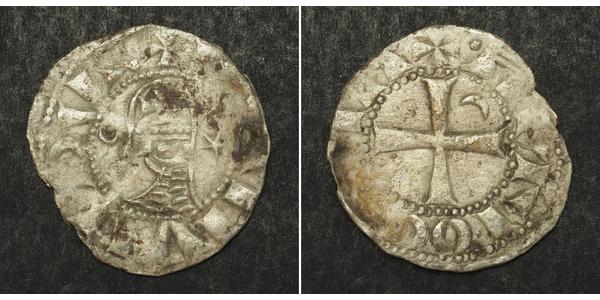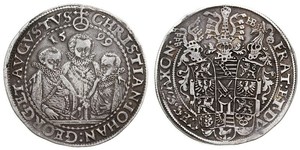(sold for $28.0)
1163, Crusader States, Antioch, Bohemond III. BI Denier Coins. Unusual Variety!
Denomination: Denier Ruler (King): Bohemond III Mint Period: 1149-1163 AD. Reference: Metcalf Crusades 381. Mint Place: Antioch (Crusader City State). Condition: Rusty deposits, lightly chipped flan, environmental damage, otherwise F-VF! Material: Billon (low grade silver alloy) Diameter: 17mm Weight: 0.73gm
Obverse: Helmeted bust in chain mail left. Cross inside helmet. Crescent in left field, star in right field. Legend: + BOAMVNDVS
Reverse: Cross pattee, crescent in second quadrant. Interesting variety with thick dots as borders and more crude legends! Legend: + ANTIOCHIA
The Principality of Antioch was one of the crusader states created during the First Crusade which included parts of modern-day Turkey and Syria. The principality was much smaller than the County of Edessa or the Kingdom of Jerusalem. It extended around the northeastern edge of the Mediterranean, bordering the County of Tripoli to the south, Edessa to the east, and the Byzantine Empire or the Kingdom of Armenia to the northwest, depending on the date. It had roughly 20,000 inhabitants in the 12th century, most of whom were Armenians and Greek Orthodox Christians, with a few Muslims outside the city itself. Most of the crusaders who settled there were of Norman origin, notably from the Norman Kingdom of southern Italy, as were the first rulers of the principality, who surrounded themselves with their own loyal subjects. Few of the inhabitants apart from the Crusaders were Roman Catholic even though the city was set under the jurisdiction of the Latin Patriarchate of Antioch, established in 1100. This patriarchate would endure as a titular one after the Crusades, until it was dropped in 1964.
em>.
Bohemond III of Antioch (1144 – 1201), also known as the Stammerer, was Prince of Antioch from 1163 to his death. He was a son of Constance of Antioch by her first husband Raymond of Poitiers. His name is sometimes spelled Bohemund.
Bohemond's father was killed at the Battle of Inab in 1149, and his mother ruled as regent until he was old enough to rule on his own. Constance, however, married a second time, to Raynald of Chatillon, who ruled as Prince of Antioch until being taken captive and imprisoned in Aleppo in 1160 (he remained there until 1176). Bohemond was by now of legal age to succeed, but Constance refused; King Baldwin III of Jerusalem intervened and declared Bohemond ruler of the principality. In 1163 Constance asked the Armenian Kingdom of Cilicia for aid in order to maintain her rule; the citizens of Antioch then rioted and exiled her. She died later that year, allowing Bohemond to take full control.
In 1164, Bohemond and Raymond III of Tripoli marched out to relieve Harim, under siege from Nur ad-Din, but when Nur ad-Din retreated Bohemond led a charge against him. The ensuing battle was a disaster and both Bohemond and Raymond were taken prisoner. King Amalric I of Jerusalem hastened back from his invasion of Egypt to take control of the regency of Antioch; Bohemond was freed, for a large ransom, in 1165 with the intervention of Amalric and Byzantine emperor Manuel I Comnenus, his nominal overlord; Manuel was also his brother-in-law, as he was married to Bohemond's sister Maria of Antioch. Nur ad-Din was always wary of Byzantine intervention in Syria, which may explain his quick release of Bohemond. Bohemond then visited Manuel in Constantinople, where he agreed to re-establish a Greek Patriarch in Antioch, Athanasius II. The Latin Patriarch, Aimery of Limoges, protested this and imposed an interdict on the city. He did not return until Athanasius died in 1170.
In 1166 the future emperor Andronicus Comnenus, then only governor of Cilicia, arrived in Antioch, having heard of the beauty of Bohemond's sister Philippa. Their subsequent affair angered both Bohemond and Manuel, as Philippa was the sister of Manuel's wife and thus the relationship was considered incestuous by the church. Andronicus was forced to flee to Jerusalem, where he also seduced Queen Theodora Comnena, an even closer relative.
In 1172 Bohemond invaded Armenia, in response to Mleh of Armenia's alliance with Nur ad-Din. In 1177, along with Raymond III and Philip, Count of Flanders, who had arrived on pilgrimage, Bohemond besieged Harim, but they could not recapture it and the siege was abandoned.
In 1180 Bohemond and Raymond attempted to intervene in the Kingdom of Jerusalem, which was at the time ruled by their kinsman Baldwin IV, a leper. Because Baldwin could have no heirs, it was vital that his sister Sibylla be married to a suitable candidate for the kingship. After the death of her first husband, William of Montferrat, Baldwin had been trying to negotiate another foreign marriage for her. Raymond and Bohemond, both firsts cousin of Baldwin and Sibylla, brought their forces into the kingdom with the intention of marrying her to one of their supporters, Baldwin of Ibelin. The king pre-empted them by marrying her off to Guy of Lusignan.
Only 1$ shipping for each additional item purchased!

|
Posted by:
anonymous 2019-04-29 |
1 Thaler States of Germany Silver
group has 61 coins / 57 prices
⇑
2 Mark Hamburg / Germany Silver
group has 66 coins / 65 prices
⇑















